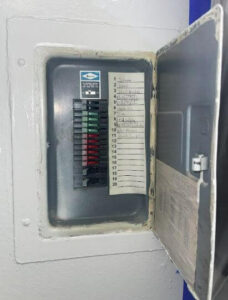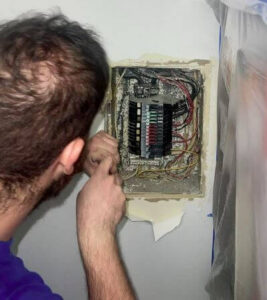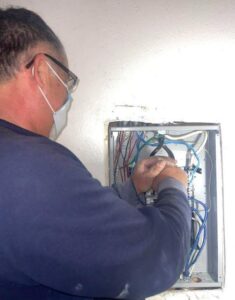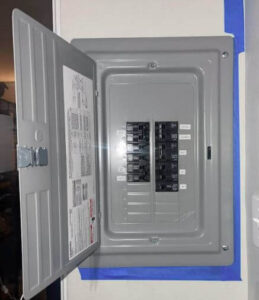However, many older multifamily buildings are equipped with outdated electrical panels, such as Zinsco, Federal Pacific, Challenger, or Pushmatic panels, which have garnered a notorious reputation for their safety issues.
In this article, we will explore the dangers associated with these panels, why there is a need to replace them, and whether insurance companies are requiring a change.

The Dangers of Zinsco, Federal Pacific, Challenger, or Pushmatic Panels
The Need for Panel Replacement
How to hire the right electrician for the job.
The Dangers of Zinsco, Federal Pacific, Challenger, or Pushmatic Panels
Zinsco Panels: Zinsco, or GTE Zinsco-Sylvania, electrical panels were popular in the mid-20th century. However, these panels have several inherent issues, including:
- Stab-lok Breakers: Zinsco panels are notorious for their “Stab-lok” breakers, which are known to trip infrequently or not at all when overloaded, posing a severe risk of overheating and electrical fires.
- Aging Components: Over time, Zinsco panels tend to deteriorate, resulting in loose connections and poor electrical contact, which can lead to overheating and potential hazards.
- Obsolete Design: The Zinsco design does not meet modern electrical safety standards and is no longer manufactured.

Federal Pacific Panels: Federal Pacific Electric (FPE) Stab-Lok panels were widely used in residential and multifamily buildings from the 1950s to the 1980s. The primary concerns associated with these panels include:
- Breaker Reliability: FPE breakers are known to have a high failure rate, meaning they may not trip as intended during overloads, which can lead to overheating and electrical fires.
- Lack of Certification: FPE panels lost their UL certification due to serious safety concerns, further highlighting the potential dangers.
Challenger Panels: These panels were built by the Challenger Electrical Equipment Corp or Eaton/Cutler-Hammer and were manufactured between the 1980s and 1990s. The main concerns are:
- Faulty Circuit Breakers: Challenger panels, particularly those manufactured between the 1980s and 1990s, have been reported to have faulty circuit breakers that might not trip when overloaded, posing a risk of overheating and electrical fires.
- Aging Components: Like many older panels, Challenger electrical panels may suffer from aging components, leading to loose connections, corrosion, or deteriorating breaker performance, which can compromise electrical safety.
- Obsolete Design and Parts: Challenger panels are no longer manufactured, which can present challenges when it comes to finding replacement parts or breakers. This limitation can affect the repair and maintenance of these panels, potentially leading to safety issues or necessitating panel replacement.
- Outdated Standards: Some Challenger panels might not meet current electrical safety standards and building codes, potentially leading to regulatory non-compliance and safety concerns.

Pushmatic Panels: Pushmatic panels, now discontinued, pose concerns due to:
- Obsolete Design and Parts: Discontinued manufacturing makes finding replacement parts challenging. Limited availability of qualified electricians familiar with Pushmatic panels can impact maintenance and repairs.
- Operational and Safety Issues: Breakers may not trip properly during overloads, posing fire hazards. Aging components could lead to loose connections or deteriorating breaker performance, compromising safety.
- Code Compliance Challenges: Outdated design might not meet current electrical safety standards or building codes, raising compliance concerns.
The Need for Panel Replacement
If you’re lucky, you won’t have to worry about replacing electrical panels if you don’t have the type of sub panels that your insurance company won’t insure. An electrician familiar with the requirements of insurance companies will be able to determine what kind of panels you have and if they are still considered safe by insurance companies.
There are several compelling reasons to replace Zinsco, Federal Pacific, Challenger, or Pushmatic panels in multifamily buildings:
Safety: The primary reason for replacing these panels is safety. The unreliable breakers and aging components in Zinsco, Federal Pacific, Challenger, or Pushmatic panels pose a significant fire hazard. Upgrading to modern panels with better safety features reduces the risk of electrical fires and injuries.
Code Compliance: Many local electrical codes and regulations now require the installation of panels that meet modern safety standards. Non-compliant panels can result in code violations and fines.

Insurance Company Requirements: While not all insurance companies explicitly mandate panel replacement, some do. Insurers are increasingly aware of the hazards associated with Zinsco, Federal Pacific, Challenger, or Pushmatic panels and may require their replacement to underwrite coverage. Insurance premiums may be higher for buildings with outdated panels, as they are considered higher risk.
Resale Value: Upgrading the electrical panel in a multifamily building can increase its resale value and make it more attractive to potential buyers or tenants.
Reliability: Modern panels are more reliable and efficient, reducing the likelihood of power interruptions and ensuring uninterrupted electrical service.
While insurance companies may not universally require panel replacements, they increasingly recognize the hazards associated with these panels and may incentivize or mandate upgrades.
Additionally, adhering to modern electrical safety standards ensures that multifamily buildings are not only secure but also compliant with local regulations, protecting the well-being of all occupants.




